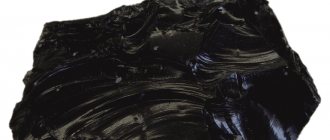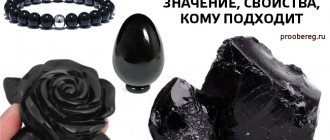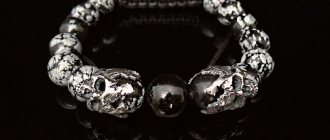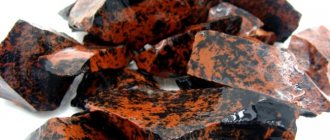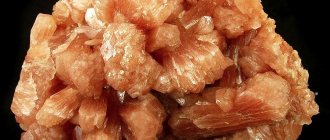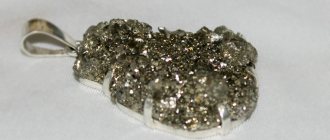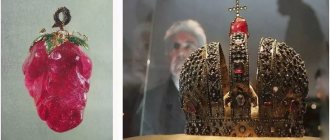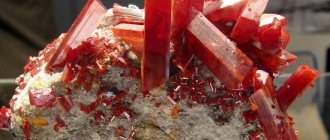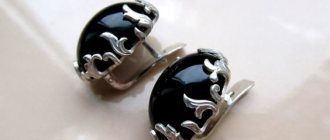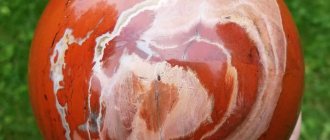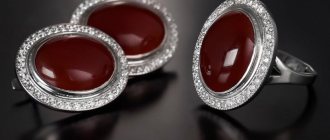| Category | Rocks |
| Title in English | Obsidian |
| Formula | SiO2 |
| Group | Acid rock group |
| Color | Black, Brown, Transparent |
| Stroke color | White |
| Shine | Glass |
| Transparency | Opaque, Translucent |
| singonia | Amorphous |
| Hardness | 5 — 6 |
| Cleavage | Absent |
| Density, g/cm³ | 2,5 — 2,6 |
| Kink | Large-shelled |
| origin of name | The name obsidian has two origins. According to the first, mirrors were made from this igneous rock, so the ancient Greek word οβσις was used for the name. It is translated into Russian as a spectacle. According to another version, the stone was named after the Roman Obsidia, who once brought the mineral from Ethiopia to Rome for the first time. The full name was Obsidianus lapis, which is translated from Latin as Obsidia stone. |
The mineral obsidian has been known to mankind for about 9,000 years. The mineral received its name in honor of the Roman Obsidius. Obsidian is found in lava that hardens after volcanic eruptions. And already in the Paleolithic, people could easily make a knife, ax or spear based on this stone. As stone processing technologies developed, obsidian became more and more famous. At the end of the 19th century, its popularity increased significantly due to its use in Faberge products. Now obsidian is widely used in jewelry and as an ornamental stone.
Obsidian deposits
The largest obsidian deposits are located in Ecuador, Mexico, Indonesia, Japan, Ethiopia, Peru, Germany, Turkey, Armenia, Iceland and the USA, wherever there are zones of volcanic activity in ancient or modern times. In Russia, obsidian deposits were found in Kamchatka, the Caucasus and Siberia. Iridescent obsidians are found in Nevada and the Hawaiian Islands.
Where were the volcanoes
The name gives a hint as to where to look for the bottle stone. Volcanic glass occurs where there were (or are) volcanoes.
Central America
middle Asia
Canary Islands
Iceland
Russia
Countries with obsidian deposits:
- Central America;
- Middle Asia;
- Canary Islands;
- Iceland.
In Russia, look for volcanic glass in the Kuril Islands and Kamchatka (who would doubt it); in Transbaikalia, Primorye, in Transcarpathia.
History of obsidian
— Advertising —
For the first time, obsidian was brought from Ethiopia to Europe by a Roman named Obsidius, which was the reason for the appearance of this name for the stone. Obsidian was known by different names among different peoples. For example, in Transcaucasia, as “a fragment of Satan’s claws”, in America as “tears of the Apaches”. The Greek term "obsis" translates as "spectacle", and may also have had an influence on the formation of the mineral, as in ancient times it was used to make mirrors.
During the Stone Age, primitive people used obsidian in the manufacture of knives, arrowheads, and scrapers. They were sharper than metal ones and therefore popular. In Egypt, incense was stored in obsidian vessels to preserve its qualities. Writing utensils were also made from the stone, as it was believed that obsidian had a beneficial effect on the thought process of its owner. Residents of the Caucasus and India endowed obsidian with magical properties and used it as a ritual stone.
Obsidian gained popularity in jewelry at the end of the 19th century, when Carl Faberge began using it in this capacity.
From stone ax to souvenir
It will take a long time to describe the joint path of man and volcanic glass. Therefore, we will quickly go over the beginning of the friendship between man and stone.
Our time machine is at your service. Route: our days - Paleolithic, Stone Age - our days. Stops on request. Let's go back to the dawn of humanity, 2.5 million years ago. Then appearance did not matter, and hominids (our ancient ancestors) tried not to live, but to survive.
It was hard to survive; there were no shops or jobs with a stable salary. We had to exist according to the principle “what goes around comes around.”
To eat a fried steak, you had to first get it (when it grunted or growled).
Metal products appeared 8000 BC, but I wanted to eat long before that.
Our clever ancestors came up with stone tools. Obsidian stone was ideal for them. It is easy to make piercing and cutting tools from it to kill a mammoth or deer. Because throwing yourself bare-handed at a cave bear is dangerous to your health. Another thing is the spear.
Our ancestors highly valued the properties of obsidian. So much so that they were not content with local stones, but organized expeditions to the places where obsidian stones were mined.
For history buffs: many obsidian spearheads were discovered in the Baksan region of the Kabardino-Balkarian Republic. And for the stone for the tips, the Neanderthals went as far as 250 kilometers, to the Zayukinsky spring.
Later they began to make stones... no, not jewelry. Ritual items for priests who enjoyed enormous influence in the tribe. The razor-sharp edges of obsidian knives were perfect for ripping open the flesh of unfortunate victims.
The Aztec and Mayan tribes, notorious for mass sacrifice, cut out the hearts of living people with ritual obsidian knives.
We recommend: HAWKEYE - the universe is looking at us
The priest or shaman decided who to sacrifice.
While men were running after mammoths, women were in secondary roles. But hunting is an unreliable business. While the men were hunting, the woman spent the whole day collecting roots, herbs, and berries. And she tried to cultivate them. Thus began the era of agriculture, and with it matriarchy. Women took power. Well, as the saying goes, “he who feeds the food, also ... calls the tune.”
- It's time for decorations. Including obsidian jewelry.
- Glyptics is the first jewelry craft of man.
- It is in the nature of a woman to decorate herself, whether she is a Neanderthal or a businesswoman of the 21st century.
- So our beads, pendants, pendants originated a very long time ago.
- And they fell in love not only with women, but also with men.
Historical fact: Mark Antony (the same lover of Cleopatra) was a prominent politician and military leader. I wanted to have the gem of Senator Nonnius to the point of madness. The senator valued the gem and did not want to part with his favorite piece of jewelry. It was within Anthony’s power to throw an unyielding senator into lifelong exile from Rome, which was done. Nonnius's career collapsed, but his beloved gem remained with him.
This is how highly valued jewelry was in the Hellenistic era.
Further - more, jewelry has become an indicator of success and wealth. So it was, so it is. Most likely it will.
And volcanic glass, which helped people survive at the dawn of mankind, now works peacefully in production and in jewelry.
This is the importance of obsidian in human development.
Physico-chemical characteristics of obsidian
Obsidian is a glassy rock of volcanic origin, which is why it is sometimes called volcanic glass.
Its formation occurs during the rapid cooling of lava, which spills onto the ground during a volcanic eruption. Obsidian is an amorphous stone. By chemical nature it is silicon oxide with admixtures of magnesium and iron oxides. — Advertising —
Obsidian is colored in shades of gray, brown, red and black. It has an amorphous system and a conchoidal fracture. The hardness of the stone is 5-6 on the Mohs scale. Specific gravity 2.3 g/cm3.
Receipt
Destruction
Obsidian can be mined with either a diamond or netherite pickaxe.
| Block | Obsidian | |
| Strength | 50 | |
| Time of destruction | ||
| Default | 75 | |
The “Efficiency” enchantment on the pickaxe speeds up the obsidian mining process by 23%. Below are the mining times for each enchantment level.
| Tool | Enchantment | Mining time |
| Diamond pickaxe | No | 9.4 s |
| Efficiency I | 7.25 s | |
| Efficiency II | 5.55 s | |
| Efficiency III | 4.3 s | |
| Efficiency IV | 3.3 s | |
| Efficiency V | 2.5 s |
Natural generation
Obsidian can be found in the chests of village forges, bastion ruins, and destroyed Nether portals.
Obsidian is generated as part of obsidian pillars, End ships, underwater canyons and destroyed Nether portals.
Can be generated randomly if water flows onto the lava lake in the cave.
Barter
A Piglin can exchange a gold bar for 1 block of obsidian.
Types of obsidian
There are several subspecies of obsidian depending on color:
- “Peanut” or “snowy”, painted in gray-white color, and “snowflakes” seem to be scattered across its surface.
- Rainbow is distinguished by unique color tints that resemble oil drops. The most valuable and expensive subspecies.
- Red obsidian.
- Green obsidian.
- Blue-blue obsidian.
What is volcanic glass?
There are several types of volcanic glass:
- Resin stone (pechstein) , it also has options - diabase, liparite, phonolite stones. It can be black, brown (very light or dark), green, red-brown. The shine is greasy, resinous.
- Snow obsidian . Black in color with white spots of various shapes. The most interesting specimens are covered with snowflake-like spots. It is sometimes called "peanut obsidian".
- Rainbow obsidian . It is rare and therefore valuable. When cut, it often resembles a rainbow film of gasoline. Painted in blue, reddish, greenish colors and their shades.
We recommend: Mineral of eloquence and equanimity | BLUE AGATE
The stone looks very presentable. Impenetrable depth, shine, bright color attracts the eye.
The magical properties of obsidian
It is believed that obsidian contains the power of the Sun, Saturn and Uranus, and people have turned to its magical abilities since ancient times.
So, special balls for fortune tellers were made from it. As a protective amulet, obsidian keeps the owner from committing bad deeds and helps fight shortcomings. It protects from the evil eye and negative energy. The mineral gives composure, the ability to concentrate and focus on the most important, makes thoughts precise and sharp. For this reason, writing instruments are often made from it. In the Caucasus, obsidian was considered the patron saint of children, capable of protecting them from harm, the evil eye and damage.
Connects times
Astrologer L. Nazarova classifies obsidian as a group of connector stones. In addition to obsidian, this group includes cacholong, turquoise, adularia, hematite, and aventurine.
Connector stones facilitate the connection of times and the transition from one time of life to another. For example, youth-maturity.
Therefore, people in a “midlife crisis” simply need an obsidian talisman.
Zodiac signs
- Stone of the second decade of Sagittarius.
- For Scorpios, obsidian is the zodiac stone.
- Obsidian will become a real protector for all fire signs (Aries, Leo, Sagittarius).
- Astrologers do not recommend the stone for Virgos and Cancers.
- Pisces can wear obsidian from time to time, intermittently.
Is Obsidian Right for You?
Not really
Element
Fire
Earth
Planets
Sun
Saturn
Uranus
Pluto
Energy
Yin
Medicinal properties of obsidian
Traditional medicine uses obsidian to treat colds that appear during hypothermia.
It is also believed to have a positive effect on the gastrointestinal tract. Obsidian beads and rosaries normalize blood pressure. In general, obsidian is useful as a preventative. But wearing it all the time is not recommended.
Physical and chemical properties
Obsidian is a stone that is mined from volcanic rock. Its other name is volcanic glass. Due to its origin, the mineral has low wear resistance. It is fragile and has a foamy structure. The composition is acidic, similar to granite.
Obsidian contains a high content of silicic acid and alumina. Otherwise, the mineral is similar to granite. It does not contain water, is polished and has a vitreous luster. Obsidian belongs to the newest rocks with a unique amorphous structure.
Due to the viscous nature of lava, the stone is often found in association with rhyolite and liparitic porphyry.
| Formula | SiO2 oxide with acidic content |
| Color | Black, brown, red, transparent |
| Shine | Glass |
| Transparency | Transparent and opaque |
| Hardness | 5-6 |
| Cleavage | Absent |
| Kink | Large-shelled |
| Density | 2.5-2.6 g/cm³ |
| Radioactivity | No |
| Melting temperature | 1300-1500 °C |
In terms of physical properties, obsidian can be compared to glass. When split, it forms many fragments with sharp edges. Because of this, the mineral played a big role in the history of mankind - in the places where it was formed, people could make weapons and jewelry.
Branches of application of obsidian
Obsidian fragments have sharp cutting edges, which is why ancient people began to use the mineral.
Scrapers, knives, spears, axes, arrowheads - all this was made on the basis of this mineral. Obsidian artifacts discovered in Mesopotamia date back about 9,000 years. Later, various jewelry and amulets, household items and ritual figurines began to be made from obsidian. The Aztecs and Ethiopians learned to make mirrors from it. Obsidian knives became objects of rituals. And, despite the fact that people learned to make such iron products, obsidian did not lose its leadership position.
Obsidian began to be widely used as a jewelry and ornamental stone in the 19th century. Carl Faberge was the first to draw attention to the interesting properties of the stone and its attractive appearance. Today, obsidian is in demand among other semi-precious stones for making watches, writing sets, fountains, animal figurines, beads, key rings, and rosaries.
The mineral has also found application in industry as an intumescent filler for lightweight concrete.
Variegated mix
You cannot wear obsidian all the time. It is impossible to be constantly careful; this will ultimately create a coward and deprive one of initiative.
Obsidian is used as a filler for lightweight types of concrete, as well as for thermal insulation and in the manufacture of dark glass.
For fantasy lovers: the mysterious “dragon glass” is our obsidian.
Astrologers rank obsidian among the stones of Pluto.
It is allowed to make icons with prayer texts from obsidian. Only a few stones have received this honor.
Among the inhabitants of Transcaucasia, it was widely believed that pieces of obsidian were fragments of Satan’s nails.
A bust of the Egyptian pharaoh Senusret III, made of obsidian, is kept in Lisbon.
How to distinguish real obsidian from a fake
Counterfeits of natural obsidian are often made from painted glass; they can be distinguished by the following characteristics:
- Natural stone has a rich matte color and pronounced shine.
- A piece of natural origin stays cold in your hands for a long time, unlike glass that heats up quickly.
- Natural stones never have a uniform structure and contain inclusions.
- When immersed in water, imitations lose their shine and color saturation.
Links[edit]
- Peter Roger Stuart Moore (1999). Ancient Mesopotamian materials and industry: archaeological evidence. Eisenbrauns. P. 108–. ISBN 978-1-57506-042-2.
- Erickson, J.E.; Makishima, A.; Mackenzie, J.D.; Berger, R. (January 1975). "Chemical and physical properties of obsidian: a natural [sic] glass." Journal of Non-Crystalline Solids
.
17
(1): 129–142. Authorization code: 1975JNCS…17..129E. DOI: 10.1016/0022-3093 (75) 90120-9. - Obsidian. Mindat.org
- Rafferty, John P. (2012). Rocks
(1st ed.). New York, NY: Britannica Educational Pub. in association with Rosen Educational Services. p. 97. ISBN 9781615304929. - Jump up
↑ Raymond, Loren A. (1995).
Petrology: the study of igneous, sedimentary, metamorphic rocks
. Dubuque, IA: Wm. K. Brown. paragraph 27. ISBN 0697001903. - Brian Cotterell; Johan Kamminga (1992). The Mechanics of Preindustrial Technology: An Introduction to the Mechanics of Ancient and Traditional Material Culture. Cambridge University Press. P. 127–. ISBN 978-0-521-42871-2. Retrieved September 9, 2011.
- ↑
Pliny the Elder (translation by John Bostock, Henry Thomas Riley) (1857).
Natural History of Pliny. 6
. HG Bohn. ISBN 978-1851099306. - Dictionary of Greek and Roman Biography and Mythology
, vol. III, page 2 ("Obsidius"). - obsidian The Concise Oxford Dictionary of English Etymology. Oxford University Press (1996). Retrieved November 20, 2011.
- D Harper. obsidian Etymology online. 2012-06-17
- M. H. Manser. Facts about the File Dictionary of Allusions. Information Base, 2008, ISBN 0816071055.
- ME Malainey. A Consumer's Guide to Archaeological Science: Analytical Methods, Springer, 2010 ISBN 1441957030
- P. L. Barnes-Swarney; THOSE. Svarney (2004). A Useful Answer Book on Geology. Visible Ink Press. paragraph 123. ISBN 978-1578591565.
- M Martini; M Milazzo; M. Piacentini; Società Italiana di Fisica (2004). Physical Methods in Archaeometry. 154
. iOS Press. ISBN 978-1586034245. - Putnam, William S. (1938). "Mono Craters, California." Geographical Review
.
28
(1): 68–82. DOI: 10.2307/210567. JSTOR 210567. - Binder, Didier; Gratuse, Bernard; Muralis, Damas; Balkan-Atly, Nur (December 1, 2011). "New studies of the Göllüdag obsidian lava flow system: a multidisciplinary approach." Journal of Archaeological Science
.
38
(12):3174–3184. DOI: 10.1016/j.jas.2011.05.014. - ↑
O'Keefe, John A. (1978).
"Tektite problem". Scientific American
.
Mann and company. 239
(2):116–127. Bibcode: 1978SciAm.239b.116O. DOI: 10.1038/Scientificamerican0878-116. JSTOR 24960359. - Sevigny, Melissa L. (2016). Beneath the Desert Sky: How Tucson Mapped the Path to the Moon and Planets
. Tucson: Sentinel Peak. paragraph 93. ISBN 9781941451045. - ↑
Pan Ming Huang;
Yunkun Li; Malcolm E. Sumner, ed. (2012). Handbook of Soil Science: Properties and Processes
(second ed.). Boca Raton: CRC Press. pp. 20–24. ISBN 978-1-4398-0306-6. - Jump up
↑ Marshall, Royal R. (October 1, 1961).
"Devitrification of natural glass." GSA Bulletin
.
72
(10):1493–1520. Bibcode: 1961GSAB...72.1493M. DOI: 10.1130/0016-7606(1961)72[1493:DONG]2.0.CO; 2. - "Perlite - Mineral Deposit Profiles". BC. Geological Survey. Archived from the original on 2008-05-09. Retrieved November 20, 2007.
- ^ a b Ma, Chi; Rossman, George (2013). "Nanomineralogy of Gemstones: From Genesis to Discovery" (PDF). Mineralogical Journal
.
77
(5): 1661. DOI: 10.1180/minmag.2013.077.5.13. hdl: 10174/9676. Retrieved May 1, 2022. - Nadin, E. (2007). "The Secret Life of Minerals" (PDF). Engineering and Science
(1): 10–20. - Bonetti, R.; Di Cesare, P.; Guglielmetti, A.; Malerba, F.; Migliorini, E.; Oddone, M.; Bird, JR; Torrence, R.; Bultitude, R. J. (November 25, 1998). "Fission track dating of obsidian source samples from the Willaumez Peninsula, Papua New Guinea and eastern Australia" (PDF). Records of the Australian Museum
.
50
(3): 277–84. DOI: 10.3853/j.0067-1975.50.1998.1286. - Washington Obsidian Source Map Archived 2015-08-21 at the Wayback Machine. obsidianlab.com. Retrieved November 20, 2011.
- Oregon Obsidian Sources. Sourcecatalog.com (11/15/2011). Retrieved November 20, 2011.
- Ian Morley and Colin Renfrew. The Archeology of Dimension: Understanding Heaven, Earth and Time in Ancient Societies, Cambridge University Press, 2010 ISBN 0521119901.
- E Blake; A.B. Knapp (2005). The Archeology of Mediterranean Prehistory. John Wiley and Sons. ISBN 978-0631232681.
- Prince Mikasa no Miya Takahito. Essays on Anatolian Archaeology, Otto Harrassowitz Verlag, 1993 ISBN 3447033959.
- L Romano. 6 ICAANE, Otto Harrassowitz Verlag, 2010 Volume 3 of the Proceedings of the 6th International Congress on the Archeology of the Ancient Near East: May 5–10, 2009. ISBN 3447062177.
- PRS Muri. Ancient Mesopotamian materials and industry: archaeological evidence Eisenbrauns, 1999 ISBN 1575060426.
- ↑
Bunny, Sarah (April 18, 1985).
"Ancient Obsidian Trade Routes". New scientist
. - Schmandt-Bessera, D. (1979). Early Technologies
.
3
. Malibu, CA: Undena Publications. ISBN 0890030316. - Merrick, H.V.; Brown, F.H.; Nash, W. P. (1994). Society, Culture and Technology in Africa Import. eleven
. Published by Univ Museum Pubns. ISBN 1931707057. - JD Fage. The Cambridge History of Africa: from c. 1600 to s. 1790, part 1050, Cambridge University Press, 1979 ISBN 0521215927
- National Museum of Kenya. Karyandusi. Archived October 24, 2007 at the Wayback Machine. Retrieved June 30, 2012
- Martinelli, Maria Clara; Tykot, Robert H.; Vianello, Andrea (20 April 2022). “Lipari (Aeolian Islands) Obsidian in the Late Neolithic. Artifacts, supplies and functions". Open Archaeology
.
5
(1): 46–64. DOI: 10.1515/Opara-2019-0005. S2CID 150094926. - Brown, Keri A.; Tykot, Robert H. (August 2022). "Obsidian in Tavoliere, South-Eastern Italy - a regional study". Journal of Archaeological Science: Reports
.
20
: 284–292. DOI: 10.1016/j.jasrep.2018.04.035. - A. M. Pollard; Carl Heron (2008). Archaeological Chemistry. Royal Society of Chemistry. ISBN 978-0854042623.
- Oates, J.; McMahon, A.; Karsgaard, P.; Quntar, S. A.; Ur, J. (2015, January 2). "Early Mesopotamian Urbanism: New Views from the North" (PDF). Antiquity
.
81
(313): 585–600. DOI: 10.1017/S0003598X00095600. - Tripkovic, Boban (2003). "Quality and value in Neolithic Europe: an alternative view of obsidian artifacts". South-Eastern Europe Proceedings of the ESF Seminar, Sofia
.
103
: 119–123. Retrieved June 21, 2022. - ^ ab "John Dee's Spiritual Mirror - British Library". 2020-04-01. Archived from the original on 2020-04-01. Retrieved April 1, 2022.
- John Noble Wilford (2010-04-05). "In Syria - a prologue of cities". New York Times
. - George Robert Rapp (2002). Archaeominerology. Springer. ISBN 978-3540425793.
- Elina, Joseph; Levy, Thomas E.; Rowan, York M. (1996). "New Evidence of Prehistoric Trade Routes: Obsidian Evidence from Gilat, Israel." Journal of Field Archaeology
.
23
(3): 361–68. DOI: 10.1179/009346996791973873. - Brokmann, Carlos, Tipología y análisis de la obsidiana de Yaxchilan, Chiapas
, Colección Cientifica, no. 422, INAH, 2000 - S. Michael Hogan (2008). Morro Creek, A. Burnham (ed.). megalithic.co.uk. Retrieved November 20, 2011.
- Stark, Barbara L.; Boxt, Matthew A.; Gasco, Janine; Gonzalez Lauck, Rebecca B.; Hedgepeth Balkin, Jessica D.; Joyce, Arthur A.; King, Stacy M.; Knight, Charles L.F.; Krueger, Robert (2016-03-01). "Economic growth in Mesoamerica: obsidian consumption in the coastal lowlands". Journal of Anthropological Archaeology
.
41
: 263–282. DOI: 10.1016/j.jaa.2016.01.008. ISSN 0278-4165. - Mario Pino Quivido & Rayen Navarro (2005). "Geoarqueología del sitio arcaico Chan-Chan 18, costa de Valdivia: Discriminación de ambientes de ocupación humana y su relación con la transgresión marina del Holoceno Medio". Revista Geológica de Chile
.
32
. DOI: 10.4067/S0716-02082005000100004. - Naranjo, Jose A; Stern, Charles R. (2004). "Holocene tephrochronology of the southernmost (42°30′–45°S) southern Andean volcanic zone". Revista Geológica de Chile
.
31
(2): 225–40. DOI: 10.4067/S0716-02082004000200003. OCLC 61022562. - Specht, Jim (2018). "Research problems in the vicinity of the New Guinea islands." In Cochrane, Ethan E.; Hunt, Terry L. (ed.). The Oxford Handbook of Prehistoric Oceania. Oxford University Press. p. 100. ISBN 978-0-19-992507-0.
- ↑
Eric Kjellgren; Joanna Van Tilburg; Adrienne Lois Kappler (2001). Magnificent Isolation: The Art of Easter Island. Metropolitan Museum of Art. P. 39–. ISBN 978-1-58839-011-0. - ^ab Buck, B.A. (March 1982). "Ancient technologies in modern surgery". Western Medical Journal
.
136
(3):265–269. PMC 1273673. PMID 7046256. - Haviland, Washington; Prins HEL; Walrath D.; McBride B. (2010). Anthropology: The Human Challenge (13th ed.). Cengage Learning. item 196. ISBN. 9780495810841. Retrieved September 27, 2012.
- Disa, JJ; Vossoughi, J.; Goldberg, N.H. (October 1993). "Comparison of wound healing with obsidian and surgical steel scalpel in rats." Plastic and reconstructive surgery
.
92
(5):884–887. DOI: 10.1097/00006534-199392050-00015. PMID 8415970. - Fine Science Tools (FST). "FST Product Catalog". FST. Retrieved September 7, 2012.
- Manutchehr-Danay, Mohsen (2013-03-09). Dictionary of Gems and Gemology. Springer Science & Business Media. ISBN 9783662042885.
- Battis, Jess; Johnston, Susan (24 January 2015). Mastering a Game of Thrones: Essays on George R. R. Martin's A Song of Ice and Fire. McFarland. ISBN 9781476619620.
- ↑
Verhoeve, Remy J. (April 2011). Rereading Game of Thrones: A Critical Response to George R.R. Martin's Fantasy Classic. Nimble Books LLC. ISBN 9781608881154.
How to care for obsidian
Since obsidian is a fairly fragile mineral, jewelry made from it is stored in separate soft cases.
They should not be left in the bright sun or in water for a long time. Obsidian is also protected from temperature changes and mechanical damage. The use of chemicals is not recommended for cleaning products. It is better to use a mild soap solution or cold running water, then wipe the product with a soft cloth.
Achievements
Main article: Achievement system
| Icon | Achievement | Description | Task | Availability | Xbox Points | Trophy type (PS) | |||
| Xbox | PS | Bedrock | Nintendo | ||||||
| Into The Nether | Build a portal from obsidian - 4 blocks wide and 5 blocks high, and set it on fire with flint to get to the Nether. | Light the portal to the Nether. | Yes | PS3 | Yes | Yes | 40G | Silver | |
| PS4, Vita | Bronze | ||||||||
| Enchanter | Use 1 book, 4 obsidians and 2 diamonds to assemble an enchanting table. | Take the enchanting table from the crafting grid. | Yes | PS3 | Yes | Yes | 20G | Silver | |
| PS4, Vita | Bronze | ||||||||
Main article: Achievement system (Java Edition)
| Icon | Achievement | Description | Ancestor | Task (if different) | Identifier |
| Two elements | Get Obsidian | Hot stuff | Receive an obsidian . | minecraft:story/form_obsidian |
Obsidian and zodiac sign
Obsidian is the patron saint of representatives of the Capricorn sign, whose life it will definitely change for the better and help to be brave and decisive. Obsidian also takes Leo and Sagittarius under its protection. Jewelry made from it can be worn by Scorpios, Aquarius and Gemini. Only for Cancer and Virgo the stone is not recommended, as it endows them with irritability and vindictiveness.
Which stones go with?
Ring with obsidian
Combining stones is a whole science. It is known for certain that the best combinations are made of minerals belonging to the same element. Also, according to astrologers, one should not neglect the connection of stones with the signs of the zodiac and the planets that protect them. If the stones are not aligned correctly, then at best they will cancel each other out, and at worst they will create negative vibrations.
The mineral obsidian belongs to the element of Earth. His friends":
- agate;
- nephritis;
- turquoise;
- crocodile;
- onyx;
- malachite;
- emerald;
- aventurine;
- jasper;
- amber;
- jet.
Pendant with obsidian
Of its group of Earth stones, obsidian is unique in that it “feels” well next to Fire minerals. This is due to the origin of the stone - it was born from fire. It will make a good pair:
- with pomegranate;
- topaz;
- tiger eye;
- carnelian;
- red agate;
- hematitis;
- red tourmaline;
- diamond.
Obsidian goes well with rock crystal. Their duet is most often used in meditation for enhanced cleansing and charging of the sex chakra. Together they are able to level out a person’s energy.
Interesting facts about obsidian:
- Obsidian is considered a talisman for magicians and scientists. It is believed that beads made from it develop clairvoyance, protect against negative energy, and protect from evil spirits.
- There is a widespread legend in the Caucasus about how Satan once got angry and then pieces of his nails began to fly out to the ground along with the lava. That is why the stone received the unusual popular name “Satan’s nail.”
- According to American legend, the Apache camp was once attacked by colonists. In order not to surrender to the conquerors, the local residents decided to throw themselves from the cliff into the mouth of the volcano. The women mourned their husbands for three nights, and their tears became beautiful black stones - obsidians, “tears of the Apaches.”
The magic of volcanic glass
The magical properties of obsidian allow the stone not only to protect the owner from astral attacks and negative programs. The miracle stone will also clear your protective field of negativity.
Black obsidian has the ability to “remove rose-colored glasses” from the owner, revealing the truth about himself and his loved one. At the same time, it warns against bad deeds.
The magic of volcanic glass is open to scientists and researchers. A writing instrument made from Icelandic agate would be a good gift for them.
Bracelet with obsidian
“Tears of the Apaches,” as esotericists say, create a powerful barrier against any negative energy. The stone is so strong that you will no longer shed tears because of grievances and grief. Their talisman of “Apache tears” will take over everything.
And “Apache tears” are symbols of the fortitude and vitality of the owner.
It is very useful to carry obsidian amulets with you. The stone, like a mirror, will reflect the negative energy directed at the owner and direct it to the source of evil. We recommend: Luck's Favorite GREEN AVENTURINE
Place a pebble under your pillows and bad dreams will not bother you.
Volcanic glass balls are used by magicians and mediums.
It is wise to carry an obsidian amulet with you when going on a dangerous journey.
Wearing the gem for a long time makes the owner cowardly. Obsidian is a stone of caution.
Volcanic glass works great when paired with rock crystal crystals. Gems support the best properties of a partner and do not “extinguish” them.
It is not advisable to wear volcanic glass with rubies. These gems don't like each other.
